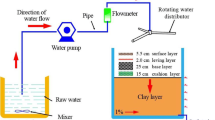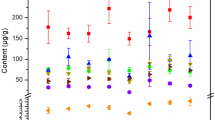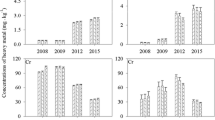Abstract
The risk of heavy metal contamination of infiltrated water and underground soil on a permeable brick paving system was investigated. The paving system was constructed as a frame structure base on top of a 1.0-m-thick clay layer with permeable ceramic brick at the surface. The concentrations of heavy metals (Zn, Cu, and Pb) in infiltrated water and soil at different underground depths under the paving system were measured. Speciation rates of Zn, Cu, and Pb at different clay depths were further determined to ascertain the probability of downward migration of the unstable forms. The results showed reduced risk of infiltrated water pollution by heavy metals due to underground soil acting as an effective trap. However, topsoil was more susceptible to heavy metal pollution, with the different pollution soil depths of Cu, Zn, and Pb mainly attributed to the different binding abilities between the heavy metals and soil. Soil Cu and Zn remained relatively stable, whereas there was a potentially high risk of Pb migration. The study found that topsoil could accumulate non-degradable heavy metals to unacceptable levels over a period of 30 years and that topsoil should therefore be replaced after 30 years to reduce the risk of soil pollution. This study fills a knowledge gap by both determining the risks of heavy metal pollution to underground soil and infiltrated water and exploring effective ways to reduce heavy metal pollution.









Similar content being viewed by others
References
Aryal RK, Murakami M, Furumai H, Nakajima F, Jinadasa HKPK (2006) Prolonged deposition of heavy metals in infiltration facilities and its possible threat to groundwater contamination. Water Sci Technol 54:205–212
Bai Y, Li Y, Zhang R, Zhao N, Zeng X (2019) Comprehensive performance evaluation system based on environmental and economic benefits for optimal allocation of LID facilities. Water-Sui 11:341
Barraud AGJPS (1999) The impact of intentional storm water infiltration on soil and groundwater. Water Sci Technol 39:185–192
Brattebo BO, Booth DB (2003) Long-term stormwater quantity and quality performance of permeable pavement systems. Water Res 37:4369–4376
Cheng HF, Xu WP, Liu JL, Wang HJ, He YQ, Chen G (2007) Pretreatment of wastewater from triazine manufacturing by coagulation, electrolysis, and internal microelectrolysis. J Hazard Mater 146:385–392
Chrastný V, Vanek A, Teper L, Cabala J, Procházka J, Pechar L (2012) Geochemical position of Pb, Zn and Cd in soils near the Olkusz mine/smelter, South Poland: effects of landuse, type of contamination and distance from pollution source. Environ Monit Assess 184:2517–2536
Davis AP, McCuen RH (2005) stormwater management for smart growth
De Macedo MB, do Lago CAF, Mendiondo EM (2019) Stormwater volume reduction and water quality improvement by bioretention: potentials and challenges for water security in a subtropical catchment. Sci Total Environ 647:923–931
Dechesne M, Barraud S, Bardin J (2005) Experimental assessment of stormwater infiltration basin evolution. J Environ Eng 131:1090–1098
Evans LJ (1989) Chemistry of metal retention by soils. Environ Sci Technol 23:1046–1056
Gavrić S, Leonhardt G, Marsalek J, Viklander M (2019) Processes improving urban stormwater quality in grass swales and filter strips: a review of research findings. Sci Total Environ 669:431–447
Ghayoraneh M, Qishlaqi A (2017) Concentration, distribution and speciation of toxic metals in soils along a transect around a Zn/Pb smelter in the northwest of Iran. J Geochem Explor 180:1–14
Hager J, Hu GJ, Hewage K, Sadiq R (2019) Performance of low impact development best management practices: a critical review. Environ Rev 27:17–42
Herngren L, Goonetilleke A, Ayoko GA (2006) Analysis of heavy metals in roaddeposited sediments. Anal Chim Acta 76:149–158
Jin JR, Li T, Shi ZB (2017) Performance of applying scale permeable pavements for control of runoff pollution in an area with high groundwater level. Environ Sci 38:2379–2384
Kabala C, Singh BR (2001) Fractionation and mobility of copper, lead, and zinc in soil profiles in the vicinity of a copper smelter. J Environ Qual 30:485–492
Lee S (2006) Geochemistry and partitioning of trace metals in paddy soils affected by metal mine tailings in Korea. Geoderma 135:26–37
Li YC, Zhang DQ, Wang M (2017a) Performance evaluation of a full-scale constructed wetland for treating stormwater runoff. CLEAN-Soil Air Water 45:1600740
Li H, Li Z, Zhang X, Li Z, Liu D, Li T, Zhang Z (2017b) The effect of different surface materials on runoff quality in permeable pavement systems. Environ Sci Pollut R 24:21103–21110
Li J, Li F, Li H, Guo C, Dong W (2019) Analysis of rainfall infiltration and its influence on groundwater in rain gardens. Environ Sci Pollut R 26:22641–22655
Lin ZZ, Yang H, Chen HM (2019) Influence of fillers on the removal of rainwater runoff pollutants by a permeable brick system with a frame structure base. Water Sci Technol 80:2231–2140
Liu A, Ma Y, Gunawardena JMA, Egodawatta P, Ayoko GA, Goonetilleke A (2018) Heavy metals transport pathways: the importance of atmospheric pollution contributing to stormwater pollution. Ecotox Environ Safe 164:696–703
Ma Y, Hao S, Zhao H, Fang J, Zhao J, Li X (2018) Pollutant transport analysis and source apportionment of the entire non-point source pollution process in separate sewer systems. Chemosphere 211:557–565
Mahanta MJ, Bhattacharyya KG (2011) Total concentrations, fractionation and mobility of heavy metals in soils of urban area of Guwahati, India. Environ Monit Assess 173:221–240
Mikkelsen PS, Häfligerb M, Ochs M, Jacobsen P, Tjell JC, Boller M (1997) Pollution of soil and groundwater from infiltration of highly contaminated stormwater - a case study. Water Sci Technol 36:325–330
Narain V (2014) Shifting the focus from women to gender relations: assessing the impacts of water supply interventions in the Morni-Shiwalik Hills of Northwest India. Mt Res Dev 34:208–213
Nicholson FA, Smith SR, Alloway BJ, Carlton-Smith C, Chambers BJ (2003) An inventory of heavy metals inputs to agricultural soils in England and Wales. Sci Total Environ 311:205–219
Pitt R, Field R, Lalor M, Brown M (1995) Urban stormwater toxic pollutants: assessment, soruces, and treatability. Water Environ Res 67:260–275
Pitt R, Clark SC, Field R (1999) Groundwater contamination potential from stormwater infltration practices. Urban Water 1:217–236
Reddy KR, Xie T, Dastgheibi S (2014) Adsorption of mixtures of nutrients and heavy metals in simulated urban stormwater by different filter materials. J Environ Sci Heal A 49:524–539
Statham TM, Mumford KA, Rayner JL, Geoffrey WS (2015) Removal of copper and zinc from ground water by granular zero-valent iron: a dynamic freeze–thaw permeable reactive barrier laboratory experiment. Cold Reg Sci Technol 110:120–128
Weiss J, Hondzo M, Biesboer D, Semmens M (2006) Laboratory study of heavy metal phytoremediation by three wetland macrophytes. Int J Phytoremediat 8:245–259
Winiarski T, Bedell JP, Delolme C, Perrodin Y (2006) The impact of stormwater on a soil profile in an infiltration basin. Hydrogeol J 14:1244–1251
Yang H, Lin ZZ, Huang X, Jia QS, Li YL, Liu YY, Chen HM (2019) Rainwater runoff pollutant removal experiment using a ceramic permeable brick system with a frame structure base. Fresenius Environ Bull 28:9924–9934
Funding
This study was supported by the Science and Technology Project of Jiangsu provincial Construction System (No. 2018ZD203), the National Natural Science Foundation of China (No. 51608272), and the Science and Technology Project of Nanjing Municipal Construction System (No. Ks1914) provided financial support.
Author information
Authors and Affiliations
Corresponding author
Additional information
Responsible Editor: Philippe Garrigues
Publisher’s note
Springer Nature remains neutral with regard to jurisdictional claims in published maps and institutional affiliations.
Rights and permissions
About this article
Cite this article
Lin, Z., Chen, H. & Yang, H. Risk of contamination of infiltrated water and underground soil by heavy metals within a ceramic permeable brick paving system. Environ Sci Pollut Res 27, 22795–22805 (2020). https://doi.org/10.1007/s11356-020-08745-w
Received:
Accepted:
Published:
Issue Date:
DOI: https://doi.org/10.1007/s11356-020-08745-w




